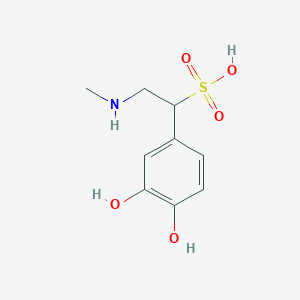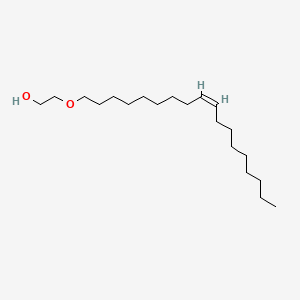
1-Azido-3-iodopropane
- 専門家チームからの見積もりを受け取るには、QUICK INQUIRYをクリックしてください。
- 品質商品を競争力のある価格で提供し、研究に集中できます。
説明
1-Azido-3-iodopropane is a useful research compound. Its molecular formula is C3H6IN3 and its molecular weight is 211.00 g/mol. The purity is usually 95%.
BenchChem offers high-quality this compound suitable for many research applications. Different packaging options are available to accommodate customers' requirements. Please inquire for more information about this compound including the price, delivery time, and more detailed information at [email protected].
科学的研究の応用
Applications in Click Chemistry
Click chemistry refers to a set of powerful reactions that allow for the rapid and efficient formation of covalent bonds. 1-Azido-3-iodopropane is particularly useful in:
- Copper-Catalyzed Azide-Alkyne Cycloaddition (CuAAC) : This reaction involves the reaction of azides with terminal alkynes to form 1,2,3-triazoles. The use of this compound facilitates the synthesis of various triazole derivatives, which have applications ranging from drug development to materials science .
| Reaction Type | Description | Applications |
|---|---|---|
| CuAAC | Reaction between azides and alkynes | Drug synthesis, materials science |
| Strain-Promoted Azide-Alkyne Cycloaddition (SPAAC) | Copper-free alternative for biological applications | Bioconjugation in living systems |
Bioconjugation and Protein Labeling
This compound is employed for bioconjugation processes, particularly in labeling proteins with fluorescent tags. For instance, bovine serum albumin (BSA) can be modified with azide groups using this compound, allowing for subsequent labeling with fluorophores through click chemistry . This method is advantageous due to its specificity and efficiency.
Case Study: Fluorescent Labeling of Proteins
A study demonstrated the use of this compound to label BSA with fluorescent dyes. The process involved:
- Treating BSA with this compound in a TRIS buffer.
- Irradiating the mixture to facilitate the reaction.
- Analyzing the resulting fluorescently labeled protein using spectroscopic methods.
This technique highlights the potential for real-time imaging and tracking of proteins in biological systems .
Pharmaceutical Applications
The compound has been explored for its potential in developing new pharmaceuticals. Its ability to form stable triazole linkages makes it a candidate for synthesizing bioactive compounds.
Case Study: Antifungal Activity
Research has indicated that derivatives synthesized from this compound exhibit antifungal properties. A series of compounds were prepared through click chemistry involving this azide, leading to promising results against various fungal strains .
| Compound | Activity | Target Organisms |
|---|---|---|
| Triazole Derivative A | Moderate | Candida albicans |
| Triazole Derivative B | High | Aspergillus niger |
Material Science Applications
In material science, this compound is utilized for modifying surfaces and creating functional materials. Its reactivity allows for the incorporation of azide functionalities into polymers, which can then undergo click reactions to create crosslinked networks or functionalized surfaces.
Case Study: Surface Functionalization
A study demonstrated the functionalization of polymer surfaces with azide groups using this compound, followed by subsequent reactions with alkyne-functionalized compounds. This approach enabled the creation of bioactive surfaces suitable for tissue engineering applications .
特性
分子式 |
C3H6IN3 |
|---|---|
分子量 |
211.00 g/mol |
IUPAC名 |
1-azido-3-iodopropane |
InChI |
InChI=1S/C3H6IN3/c4-2-1-3-6-7-5/h1-3H2 |
InChIキー |
GTBCENNLSAZFSM-UHFFFAOYSA-N |
正規SMILES |
C(CN=[N+]=[N-])CI |
製品の起源 |
United States |
試験管内研究製品の免責事項と情報
BenchChemで提示されるすべての記事および製品情報は、情報提供を目的としています。BenchChemで購入可能な製品は、生体外研究のために特別に設計されています。生体外研究は、ラテン語の "in glass" に由来し、生物体の外で行われる実験を指します。これらの製品は医薬品または薬として分類されておらず、FDAから任何の医療状態、病気、または疾患の予防、治療、または治癒のために承認されていません。これらの製品を人間または動物に体内に導入する形態は、法律により厳格に禁止されています。これらのガイドラインに従うことは、研究と実験において法的および倫理的な基準の遵守を確実にするために重要です。















